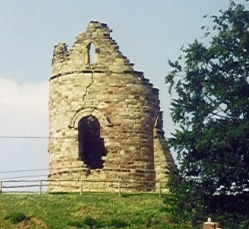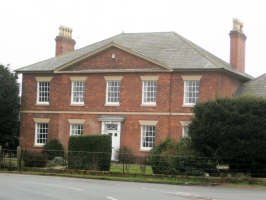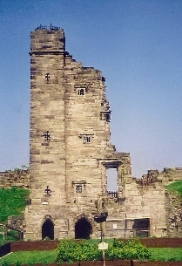Listed Buildings
Historic buildings are a precious and finite asset, and powerful reminders to us of the work and way of life of earlier generations. The richness of this country’s architectural heritage plays an influential part in our sense of national and regional identity. Our favourite views of England - street, village, town or city - almost certainly contain buildings protected by the process called ‘listing’.
Listing began in Britain on January 1st 1950, under the post-war Labour government and currently protects 500,000 or so buildings.
From 1 April 2005 English Heritage has the task of identifying and protecting this inheritance in England. The main means of doing this is by listing - recommending buildings for inclusion on statutory lists of buildings of 'special architectural or historic interest'
Listing ensures that the architectural and historic interest of the building is carefully considered before any alterations are agreed. Buildings can be listed because of age, rarity, architectural merit, and method of construction. Sometimes because the building has played a part in the life of a famous person, or as the scene for an important event.
The older a building is, the more likely it is to be listed. Most buildings built before 1700 which survive in anything like their original condition are listed, as are most built between 1700 and 1840.
- Grade I buildings are of exceptional interest
- Grade II* are particularly important buildings of more than special interest
- Grade II are of special interest, warranting every effort to preserve them
There are 38 listed buildings in Tutbury:
|
|
|---|---|
|
Belmot RoadChapel House Farm IoE Number: 27347 Date listed: 26 April 1984 Grade II Early 19th century. Brick with hipped slate roof and brick stacks.
Bold eaves, Two-storey and of 5 bays.Central pediment to slightly
projecting 3-window bay. Sash windows with plain lintels. Flat string
courses between storeys. Doorway has moulded frame and entablature
and rectangular fanlight with geometrical glazing. |
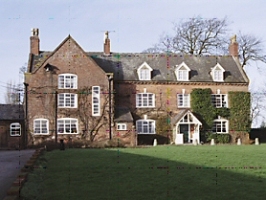 |
Castle Hayes LaneCastle Hayes Park Farmhouse IoE Number: 273477 Date listed: 26 April 1984 Grade II 17th century with later alterations. Brick with coped gables, tiled
roof and brick stacks. 2 storeys and attic. Four window front, the
left-hand bay slightly projecting with gable. C19 casement windows.
Three gabled dormers. Plain wood doorcase with C19 gabled lattice
wood porch. The interior has exposed ceiling beams in older portion,
open fireplaces and one room with a dentiled cornice. |
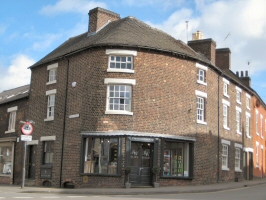 |
Burton StNo 1 IoE Number: 273476 Date listed: 26 April 1984 Grade II Early 19th century. Brick with old tile roof and brick stack. 2 storeys
& attic. Curved front to street corner having 2 sash windows with
pain lintels and centre divided glazed door flanked by shop windows. |
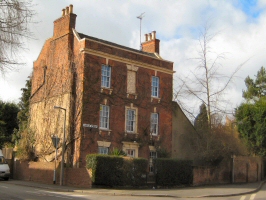 |
Castle StNo 1 IoE Number: 273479 Date listed: 17 September 1952 Grade II Town House late 18th century. Red brick with tiled roof and end brick stacks. 3 storeys and of 3 bays. Sash windows, those at first and second storey with projecting keyblocks and bracketed sills. Doorway in moulded architrave with entablature on console brackets. |
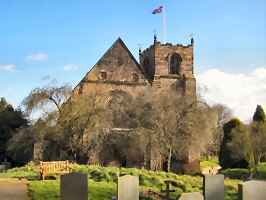 |
Church StreetChurch of of St. Mary IoE Number: 273480 Date listed: 12 March 1964 Grade I Parish Church 13th century fabric and the most important in the County. Chancel and apsidal sanctuary replaced in 1866 by G.E.Street.. S tower probably added 16th century. N aisle and addition of 1820-2 by Joseph B.H.Bennett. Stone with slate roof. Notable W front of circa 1160-70 which has a fine doorway of 7orders, the outermost order being of alabaster, the earliest known use of the material in England. S aisle retains a Norman doorway having a much weathered tympanum carving depicting a boar hunt. Interior contains little of interest. |
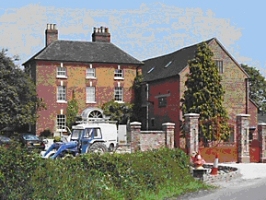 |
Cornmill LaneTutbury Mill and House IoE Number: 273481 Date listed: 12 March 1964 Grade II Former corn-mill with house attached on left hand side. Early 18th
century with later and modern alterations to the mill building. The
house which is set back is of brick, 3 storeyed, 9 bays with hipped
tiled roof, renewed sash windows with flat brick arches and keyblocks,
and wide moulded. Stucco doorcase with radial fanlight and 19th century
porch. Mill building, which is of painted brick, has 3 storey tiled
roof and plain casement windows. Interior which is much altered retains
original 20 ft. diameter wooden water wheel and part of the drive
shaft. Rear part of the building incorporates the remains of a 17th
century timber framed cottage and some timbers are exposed in what
is now a café. |
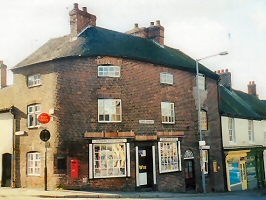 |
Duke StreetNo.1 (Post Office) IoE Number: 273482 Date listed: 26 April 1984 Grade II Small house and shop. 18th century with early 19th century alterations.
Red brick with tiled roof, 3 storeys. Centre doorway flanked each
side by a 20 pane window each with reeded wood pilasters and an entablature.
Another doorway to right with semi circular fanlight. Radiused angle
to lefthand returned side which has 1 window. |
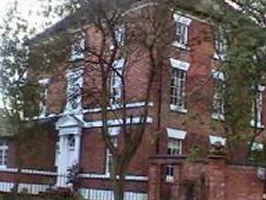 |
Duke StreetCroft House IoE Number: 273483 Date listed: 17 September 1952 Grade II Town house, late 18th century. Red brick with hipped tiled roof and
brick stacks. 3 storeys, 3 bays. Sash windows, the central at 1st
and 2nd storeys in moulded architrave. Moulded doorway has engaged
Doric columns, pediment and radial fanlight. 19th century on lefthand
side under tiled pentice. |
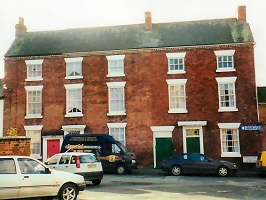 |
Duke StreetNos. 8-10 IoE Number: 273484 Date listed: 13 February 1984 Grade II Terraced range of town houses, early 19th century. Brick with toothed
eaves, tiled roof and brick stack:. 3 storeys. 5 window front. Sash
windows with plain lintels. Doorway to no 9 has reeded pilasters,
cornice on console brackets and rectangular fanlight. No 10 has plain
pilaster doorcase with weatherhood and rectangular fanlight |
 |
Duke StreetCharity Offices IoE Number: 273485 Date listed: 26 April 1984 Grade II 1844 Known locally as the 'Soup House' as a soup kitchen was instituted
here in 1901. Brick with stone dressings. 2 storeys, 3 bays, the central
lightly projecting. Sash windows with stone lintel and sills. Stone
bands. Plain stone doorcase with cornice hood on consoles and vertical
ribbed door. Moulded brick eaves. Hipped slate foot. |
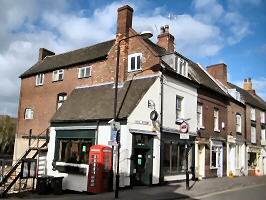 |
High Street, northwest sideNos. 1 & 2 IoE Number: 273486 Date listed: 26 April 1984 Grade II 18th century with later alterations. Brick and cement rendering 2 storeys & attic. 3 sash windows, (single glazing bars only). Old tile roof and brick stack. No. 2 has moulded wood Tuscan pilaster doorcase with rectangular fanlight and 6 panelled door. No.1 has a modern box dormer and modern shop front.
|
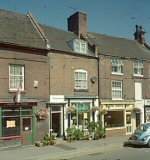 |
High Street, northwest sideNo.3 IoE Number: 273487 Date listed: 26 April 1984 Grade II 18th century with later alterations. Brick with old tiled roof and
1 modern bax dormer. 2 storeys and attic. 1 later wood casement window
under segmental head. Wood pilaster doorcase with cornice hood and
plain rectangular fanlight. Early 19th century shop front with pilaster
sides and cornice. |
High Street, northwest sideNo 4 Grade II 18th century with later alterations. Brick with old tile roof and end brick stack. 3 storeys, 3 sash windows with central blocked (generally lacking glazingbars) and with lintels of rubbed brick. Modern shop front. |
|
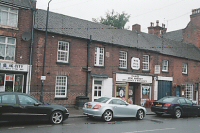 |
High Street, northwest sideNo.5 IoE Number: 273489 Date listed: 26 April 1984 Grade II Early 19th century. Brick with tiled roof, toothed eaves and end
brick stacks. 2 storeys, 4 sash windows with lintels of rubbed brick.
Moulded wood pilaster doorcase with plain rectangular fanlights, and
6 panelled door. Modern shop front on left-hand side. |
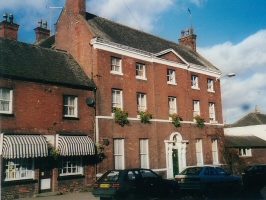 |
High Street, northwest sideNos. 6 & 6a IoE Number: 273490 Date listed: 17 September 1952 Grade II Late 18th century town house. Red brick with tiled roof and end brick
stacks. 3 and 2 storeys. No 6 has 5 sash windows (single glazing bars)
and 6a has modern sash window at 1st storey. Good Venetian type doorway
to No. 6 with cornice on consoles, radial fanlight and 6 fielded panelled
door. Facade has stone plinth, sill band at 1st storey and moulded
eaved cornice. 6a, which is an extension to 6, is slightly recessed
with carriage entrance to left of modern shop fronts. |
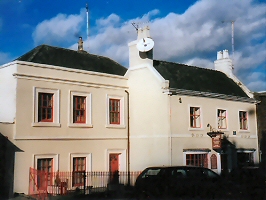 |
High Street, northwest sideNo 7 with house adjoining IoE Number: 273491 Date listed: 17 September 1952 Grade II Comprises 2 buildings, that on right hand side late 18th century
and that to left probably early 18th century. Stuccoed with tiled
roof and end brick stacks, of 2 bays and with symmetrical facade having
doorway with reeded pilasters, pediment and radial fanlight. Moulded
eaves cornice. Lef't hand side portion has 3 windows, moulded cornice
and parapet. |
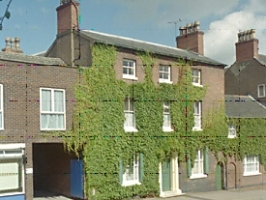 |
High Street, northwest sideNo.10 IoE Number: 273492 Date listed: 17 September 1952 Grade II Town house c1810. Red brick with slate roof and end brick stacks.
3 storeys and of 3 bays, Sash windows, (single glazing bars). Doorway
with engaged Doric columns pediment and radial fanlight. |
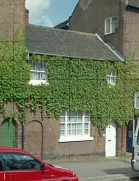 |
High Street, northwest sideNo 10a IoE Number: 273493 Date listed: 12 March 1964 Grade II Late 18th century town house with 19th century alterations. Brick
with tiled roof. 2 storey. 3 bays, the centre recessed through 2 storeys
under semi-circular arched head and containing 3 light window
at ground storey. Semi-circular headed recess on left hand side and
doorway on right with semi-circular head. Toothed eaves. |
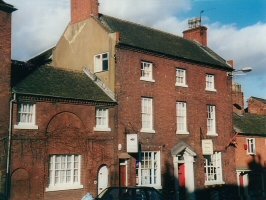 |
High Street, northwest sideNo.11 Grade II Town house c1810. Red brick with tiled roof and brick stacks. 3 bays with sash windows. Doorway with engaged Doric columns, pediment and radial fanlight. Coped gables. |
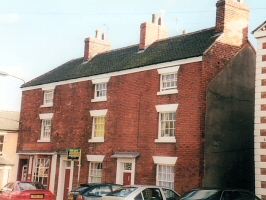 |
High Street, southeast sideNos. 22 & 24 IoE Number: 273495 Date listed: 26 April 1984 Grade II Tenement range of early 19th century. Red brick, tile roof. 3 bays,
sash windows with plain lintels. Each has a panelled pilaster doorcase
with fanlight and cornice hood. Moulded eaves cornice. |
 |
High Street, southeast sideTutbury Institute NW block, fronting street IoE Number: 273496 Date listed: 26 April 1984 Grade II Meeting hall c 1900. Red brick, gabled end to street. 2 storeys.
3 sash windows with channelled lintels. Plain band overall with clock
in gable. 23 light sash windows to ground storey. Quoins at sides. |
 |
High Street, southeast sideWeslyan Methodist Chapel IoE Number: 273497 Date listed: 26 April 1984 Grade II ChapeI building dated 1899. Red brick. 3 bays, the central slightly
projecting. 3 semi-circular headed windows with moulded keyblocks.
Gabled faced with toothed eaves plaque inscribed ' Wesleyan Methodist
Chapel' with above date, Gabled porch projecting to street. |
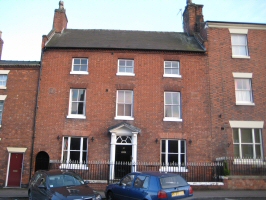 |
High Street, southeast sideNo.33 IoE Number: 273498 Date listed: 12 March 1964 Grade II Town house, probably 17th century origin, with. With early 19th century
refronting. Red brick with tiled roof and brick stacks. 3 storeys.
3 bays. Sash windows, (single glazing bars) Doorway with angled shafts,
gabled hood on curved brackets and fanlight. Toothed eaves. |
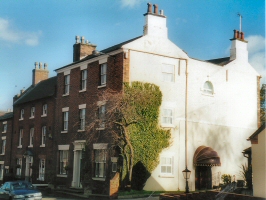 |
High Street, southeast sideNo 34 IoE Number: 273499 Date listed: 12 March 1964 Grade II Town house, Early 19th century. Red brick with slate roof and end brick stacks. 3 storeys and 3 bays. Sash windows (single glazing bars) with plain lintels. Doorway with plain pilasters, entablature and plain rectangular fanlight. |
 |
High Street, southeast sideDog and Partridge Hotel IoE Number: 273500 Date listed: 17 September 1952 Grade II* Originally a coaching inn probably late 15th century, early 16th with 18th century flanking wings. Timber framed with closely set vertical members and brick infillng on stone base. Red brick wings and additions. Tiled roofs. Mainblock of 3 storeys and attic with oversail at 1st storey and of 3 bays with leaded casement windows. Wings have casement and sash windows. Brickwork is painted except for NE gable end of main block, Bay window at ground storey. 2 modern gabled dormers. Modern additions and doorway on NW side. lnterior much altered but it retains some exposed ceiling beams. |
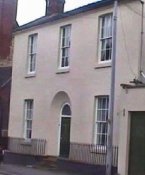 |
High Street, southeast sideNo 35 IoE Number: 273501 Date listed: 12 March 1964 Grade II* Town House early 19th century. Plastered brick with coped gables,
slate roof' and end brick stacks. 2 storeys, 3 bays. Sash windows,
Doorway with recessed segmental head and 6 panelled door. |
Lower High StNo 19 IoE Number: 273502 Date listed: 26 April 1984 Grade II Late 18th century with later alterations. Brick with modern slate
roof and brick stack. 2 storeys, 4 bays, with the righthand side bay
slightly advanced. Sash windows with plain lintels. Moulded stucco
eaves. Modern shop fronts. |
|
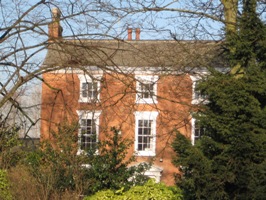 |
Lower High StRiverdale Grade II Town house set back from street at rear of garden. Late 18th century. Red brick with slate roof and end brick stacks. 3 storeys and 3 bays. Sash windows generally with gIazing bars. Doorway has engaged Doric columns, entablature and plain segmental fanlight. Moulded eaves cornice. |
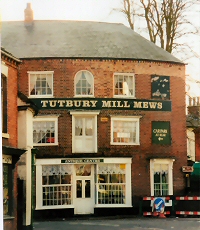 |
Lower High StNo 5 IoE Number: 273504 Date listed: 26 April 1984 Grade II Warehouse with shops at ground storey. Late 18th century. Red brick with slate roof and brick stacks. 3 storeys. Convex facade of 6 bays. Sash windows with loading door at centre of first storey beneath semi-circular window. Toothed eaves cornice. Altered shop fronts. |
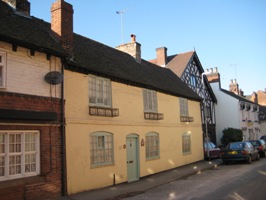 |
Ludgate StNo 28 IoE Number: 273505 Date listed: 26 April 1984 Grade II Modest cottage 17th century with later alterations. Painted brick
to earlier timber frame. 2 storeys, the lower cement rendered. 3 small
paned casement windows, those to ground storey with segmental heads.
Plain doorway. Toothed eaves. Old tiles. |
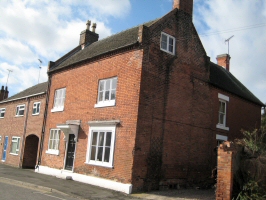 |
Monk StNo 5 Grade II Small town house, Late 18th century. Red brick with tiled roof, coped gables and end brick stacks. 2 storeys and 2 bays. Later casement windows. Plain doorcase with wood bracketed hood. Toothed eaves. |
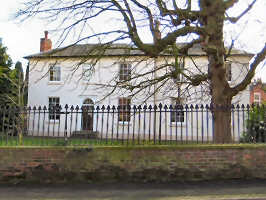 |
Monk StThe Hawthorns IoE Number: 273507 Date listed: 12 March 1964 Grade II Town house set back from street in grounds. Early 19th century altered.
Stucco with slate roof. Centre 3 bay projection. Right hand portion
of 2 bays. Sash windows. Moulded wood pilaster doorcase with radial
fanlight. |
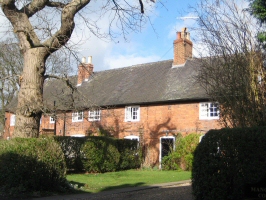 |
Monk StManor Farm Cottage IoE Number: 470512 Date listed: 14 September 1998 Grade II Farmhouse subdivided into two houses. Probably 17th century, extended
late 18th century and later 19th. Timber-framed, mostly re-clad in
red brick. Clay plain tile roof with gabled ends. Brick axial stacks.
Long 5-bay range. At the right a 2-bay timber frame, the right bay
occupied by Manor Farm Cottage, and the left bay by Manor Farmhouse
which has a 2-bay 18th/19th century extension on left and a 1-bay
later 19th century extension on the left. Small 19th century outshuts
and wing at rear. 2 storeys. Asymmetrical 7-window SW front. 2-light
casements with glazing bars, ground floor larger and with cambered
brick arches; doorways to right with plank doors; left bay splayed
back and with slanting eaves. Rear timber-framing exposed on left
with plaster and brick infill and tension-brace; single-storey brick
outshuts, and gable-ended brick wing on left. Roof over original SE
end, 2 bays with large scarfed purlins with thin wind-braces, common-rafters
with diagonally-set ridgepiece and collar-truss. 19th century common-rafter
roof over NW end. |
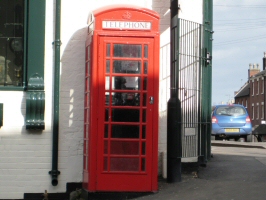 |
Duke StK6 Telephone Kiosk IoE Number: 273577 Date listed: 09 July 1991 Grade II Designed 1935 by Sir Giles Gilbert Scott. Made by various contractors.
Cast iron. Square kiosk with domed roof. Unperforated crowns to top
panels and margin glazing to windows and doors. |
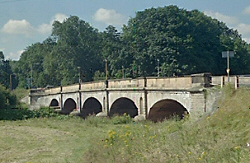 |
Bridge StTutbury Bridge IoE Number: 273572 Date listed: 24 January 1986 Grade II Bridge. 1815-17. Sandstone ashlar. Banded rustication. Five depressed
segmental arches, piers with round-arched niches and short curved
cutwaters. Bold stringcourse and coped parapet wall above. The piers
project slightly and the walls curve outwards at each end. |
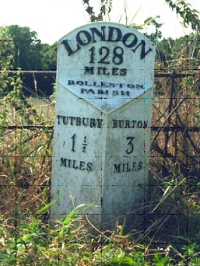 |
MilepostBurton Road (south side) Date listed: 26 March 1986 |
 |
Castle StThe Castle Grade I Castle ruins. 12th Century chapel. NE gateway of early 14th century the rest 15th century and later. On south side the present entrance is through the south wall of the former King's Lodgings of 1631-5 on the site of the former great hall and solar of which portions remain. To west, motte is crowned by a folly keep of early 19th century known as Julius's Tower. To east is the South Tower, actually 2, adjoining towers of circa 1442-50. Curtain wall extends NE to a small tower and to the North Tower beyond, built circa 1450 and terminating with the NE Gateway, known an John of Gaunt's Gateway, a fabric on early 14th century with 15th century towers. In the Bailey stand the remains of the Norman Chapel. The Castle which for long has been the property of the Duchy of Lancaster, was founded by Henry de Ferrers. Mary Queen of Scots was confined here on several occasions. Crown property and Ancient Scheduled Monument. |
no image available |
Belmot RoadLower Castle Hayes Farmhouse Grade II 16th century with later alterations and additions. Timber frame and brick on stone base with tiled roof and brick stacks. 2 storeys & attic. 4 window front. Casement windows. Central gable on front. 2 storey porch. Rear wall and ends mainly later brick. Later 1 window single storey wing on right hand side. Interior has exposed ceiling beams, framed partitions and ledged doors. |
Scheduled Monuments
A Scheduled Monument is a 'nationally important' archaeological site or historic building, given protection against unauthorised change. They are defined in the Ancient Monuments and Archaeological Areas Act 1979 and the National Heritage Act 1983. Occasionally Scheduled Monuments are also designated as listed buildings eg. Tutbury Castle.
In England the Department for Culture, Media and Sport keeps a register of nationally important sites which receive state protection. The three government bodies with responsibility for archaeology and the historic environment in Britain are: English Heritage in England, Cadw in Wales and Historic Scotland. The schedule currently includes about 19,700 entries.
Scheduling affords greater protection as it becomes illegal to undertake a great range of works within a designated area, without 'scheduled monument consent'. To be eligible for scheduling, a monument must be demonstrably of national importance.
Criteria for national importance
* Current condition
* Rarity and importance of the period to which the monument dates
* Extent of documentation enhancing the monument's significance
* Group value – where a monument forms part of a wider group of sites
* Survival/Condition
* Fragility/Vulnerability – threats from natural agencies, tourism
or development
* Whether the monument represents similar types or contains unique features
* Potential to contribute to our information, understanding and appreciation
There is no appeal against the scheduling process. Adding a monument to the schedule may require a great deal of research and consideration, but he process can be accelerated for sites under threat.
Protection can be given by taking the monument into state ownership or placing it under guardianship, where the owner retains possession, but the national heritage body maintains it and usually opens it to the public. Wider areas can be protected by designating their locations as Areas of Archaeological Importance.
Damage to a Scheduled monument is a criminal offence and any works taking place within one require Scheduled Monument Consent. Permission for non-essential works is rarely given and new building close to a scheduled monument which might damage its setting is a consideration in the planning system.
Tutbury Castle - Monument Number: SK 22 NW 2

MEDIEVAL MOTTE AND BAILEY 1071 – 1176
The motte and bailey castle was originally built by 1071 and demolished in 1175-6. It was rebuilt in the late 12th century and new work is recorded in the 13th, 14th and 15th centuries. During the civil war it was the last Royalist bastion in the county and was slighted in 1647-8. The oldest surviving parts are the chapel and north east gateway. Possibly built on the site of an Anglo-Saxon burh. Mary Queen of Scots was imprisoned here. The motte is now crowned by an early 19th century folly keep called Julius's Tower. Scheduled
MEDIEVAL CASTLE 1176 – 1199
MEDIEVAL CASTLE 1177 – 1199
MEDIEVAL CASTLE 1200 – 1499
POST MEDIEVAL CASTLE 1647 – 1648
MEDIEVAL CURTAIN WALL 1200 – 1499
MEDIEVAL GREAT HALL 1200 – 1499
MEDIEVAL INTERVAL TOWER 1200 – 1499
High Tower
MEDIEVAL GATEHOUSE - 1200 – 1499
John Of Gaunts Gateway
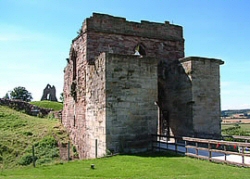
MEDIEVAL CHAPEL 1100 - 1199
Free-standing within the bailey of Tutbury Castle are the remains of the Normal chapel; a plain building of nave and narrower chancel. The west portal had one order of colonnettes. Site excavated about 1965. The nave measures 13.0 metres by 8.0 metres, and the chancel 9.0 by 6.0, with walling standing to a height of about 1.0 metre, and the floor about 1.5 metres below present ground level. A break in the west wall indicates the position of the west doorway, and the position of the altar is represented by a low stone platform against the east wall of the chancel. The stonework foundations of the chapel were drawn as part of the RCHME's National Forest Project.
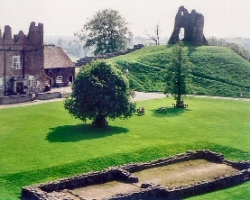
POST MEDIEVAL FOLLY 1800 - 1832
Julius Tower - possibly on the site of a Medieval shell-keep.
